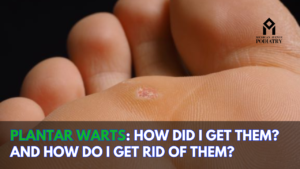Plantar warts are a common and often bothersome skin condition that can develop on the soles of the feet. Caused by the human papillomavirus (HPV), plantar warts can be unsightly, painful, and challenging to eliminate without proper treatment. In this comprehensive guide, we’ll delve into everything you need to know about plantar warts, including their causes, symptoms, treatment options, and preventive measures, with insights from podiatrists or foot doctors to ensure effective management of this common foot ailment.
Understanding Plantar Warts:
Plantar warts are benign growths that typically appear on weight-bearing areas of the feet, such as the heels or balls of the feet. These warts are caused by infection with HPV, which enters the skin through tiny cuts or breaks in the skin’s surface. Once inside the skin, the virus stimulates the growth of keratin, a protein found in the outer layer of the skin, leading to the formation of a wart.
Symptoms of Plantar Warts:
The symptoms of plantar warts can vary from person to person, but common signs include:
- Small, rough growths on the soles of the feet.
- Areas of thickened skin or calluses over the wart.
- Pain or tenderness when walking or standing, especially if the wart is located on a weight-bearing area.
- Black dots or tiny blood vessels within the wart, known as “wart seeds.”
While plantar warts are usually harmless, they can cause discomfort and inconvenience, particularly if left untreated.
Treatment Options for Plantar Warts:
Several treatment options are available for plantar warts, ranging from home remedies to medical interventions. The choice of treatment depends on the size, location, and severity of the wart. Some common treatment options include:
- Over-the-Counter Treatments: Over-the-counter wart removal products containing salicylic acid are often the first line of treatment for plantar warts. These products work by gradually breaking down the wart tissue and stimulating the immune system to attack the virus. It’s essential to follow the instructions carefully and be patient, as it may take several weeks or months to see results.
- Cryotherapy: Cryotherapy, or freezing therapy, involves applying liquid nitrogen to the wart to freeze and destroy the affected tissue. This treatment is typically performed in a healthcare provider’s office and may require multiple sessions to achieve complete wart removal.
- Laser Therapy: Laser therapy uses focused laser beams to target and destroy the wart tissue. This treatment is effective for larger or stubborn warts that have not responded to other therapies. Laser therapy is performed in a medical setting by a trained healthcare professional.
- Surgical Removal: In cases where other treatments have failed or the wart is particularly large or painful, surgical removal may be necessary. Surgical procedures for plantar wart removal may include excision (cutting out the wart) or curettage (scraping away the wart tissue).
- Immunotherapy: Immunotherapy involves stimulating the body’s immune system to recognize and attack the HPV virus responsible for the wart. This treatment may involve injecting a substance called candida antigen into the wart or applying a topical immunotherapy cream.
Preventive Measures for Plantar Warts:
While plantar warts are contagious and can spread from person to person, there are steps you can take to reduce the risk of developing or spreading warts:
- Practice Good Foot Hygiene: Wash your feet regularly with soap and water, and dry them thoroughly, especially between the toes. Keeping your feet clean and dry can help prevent the spread of HPV and reduce the risk of infection.
- Avoid Walking Barefoot in Public Areas: Wear shoes or sandals in public places such as locker rooms, swimming pools, and communal showers to minimize exposure to the virus that causes plantar warts.
- Change Your Socks and Shoes Regularly: Wearing clean socks made of breathable materials and rotating your shoes frequently can help prevent moisture buildup and reduce the risk of developing plantar warts.
- Avoid Touching Warts: If you have a plantar wart, avoid picking or scratching it, as this can spread the virus to other parts of your body or to other people. Wash your hands thoroughly after touching a wart to prevent spreading the virus.
- Seek Prompt Treatment: If you notice a wart developing on your foot, seek prompt treatment from a podiatrist or foot doctor. Early intervention can help prevent the wart from spreading and reduce the risk of complications.
Conclusion:
Plantar warts are a common foot ailment caused by infection with the human papillomavirus (HPV). While plantar warts can be unsightly and uncomfortable, effective treatments are available to remove them and alleviate symptoms. By understanding the causes, symptoms, treatment options, and preventive measures for plantar warts, individuals can take proactive steps to manage this common foot condition and maintain optimal foot health. If you have concerns about a plantar wart or other foot issues, don’t hesitate to consult with a podiatrist or foot doctor for personalized care and guidance.


